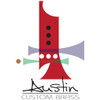The Conn 40A long model cornet has an artistic, Art Deco design concept. Every part of the horn incorporates Art Deco details, from the mouthpiece receiver to the rimless bell. One key difference between the 40A and most modern instruments is the tubing wrap; the third valve slide is on the right of the tuning slide rather than on the left. The design concept continues through the recessed water keys, faceted valve casings, bracing, and valves caps. But ultimately, it's the rimless edge that steals the show!
This cornet was made in 1935 and has a few signs of use. There are some dents and dings around the instrument, with a couple on the inner bend of the tuning slide, the knuckles where the third valve slide joins the valve block, the second valve slide crook, the third valve slide crook, and several along the length of the bell. The rim of the bell has some bending, and the throat is slightly compressed. There is some lacquer wear throughout the instrument, with more at the contact points.
All slides and valves move freely. The valves are bottom spring style valves.
Here's a video of another 40A from around the same manufacturing date:
From the Conn Loyalist site:
This is the cornet version of the 40B Connqueror Vocabell trumpet. There are several differences between the 40A and 40B. The 40A is, of course, a cornet and as such it takes a cornet mouthpiece. It also means that the internal bore is different, more conical. There are a few ways to tell a 40A from a 40B without inserting a mouthpiece to see if it fits. The 40B trumpet has a third slide finger ring, below the third slide. The 40A doesn't have a fingerring at all on the third slide. Also, the mouthpiece receiver of the 40A comes out to the bell curve. The mouthpiece receiver on the 40B comes out about an inch beyond the bell curve. The overall length of the 40B is also more than the 40A, but this might be a bit hard to see without comparing the two side by side.
The 40A has a #2 (0.468") bore. It is my understanding that the bore going in to the main tuning slide is 0.459" (#1½), and 0.466" (just shy of a #2) coming out of the main tuning slide. The "official" bore of 0.468" (#2) is measured at the 2nd valve. The 40A was produced between at least 1932 and 1938. The year 1932 is probably when production was started. It wouldn't have been produced after 1941, so that is a safe bet as an end date.
I have learned that the third slide without the finger ring to adjust the pitch of a low D and C# is slightly longer than it is on modern instruments. On modern instruments the low Eb is in tune, but the low D and C# are quite sharp. On these older cornets with the longer third slide and no finger ring the Eb is a bit flat and the D and C# are slightly sharp, but not as sharp as they are on later instruments. It was thought that the flat Eb and slightly sharp D and C# were within the abilities of the player to lip into tune.
As far as I can tell at this point, all Conn cornets built before 1958 take a short shank cornet mouthpiece as opposed to the 2¾" "Bach-style" long shank cornet mouthpiece. The long shank cornet mouthpieces won't properly fit a pre-1958 Conn cornet and won't give the proper intonation or playing characteristics of a short shank cornet mouthpiece. All of Conn's "Connstellation" cornet mouthpieces are long shank mouthpieces. The "Improved Precision" Conn mouthpieces such as the Conn 4 are long shank if there is a "ridge" halfway down the shank, and short shank if there is no ridge (in which case it is a "Precision" mouthpiece). All Conn cornet mouthpieces built before the "Improved Precision" series (ridge), such as the "Precision" series (no ridge) are short shank mouthpieces.
What Conn said in 1933
Although built in medium bore, this cornet has all the power and breadth of tone found in a larger bore because of the Vocabell. This new principle bell vibrates freely and and in sympathy with the vibrating column of air in the instrument and consequently the tone is purer, clearer and easier to produce than the tone in an instrument with the conventional bell. Delicate broadcasting instruments in the Columbia Broadcasting System Studios show the Vocabell to be superior in all respects to the instrument with the conventional bell with a wire in the rim. The volume is from 12 to 15 decibels greater, the scale is smoother and more even throughout and the tone is clearer and purer. Used by B.A. Rolfe, great cornet virtuoso and radio impressario, and other national stars. Masterpiece, both musically and in modern appearance. Bb and A, springs in bottom of valves.
No mouthpiece included. No case included unless chosen from the options above (additional charges apply based on the options you choose).
If you have additional questions send us an email.
Prior to ordering please check our Shipping and Returns policy.
Also note weight indicated in the ad is shipping weight not actual weight of item.




















